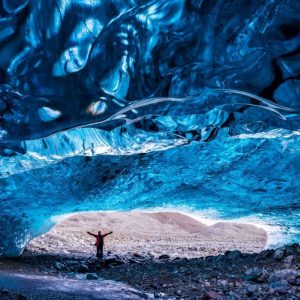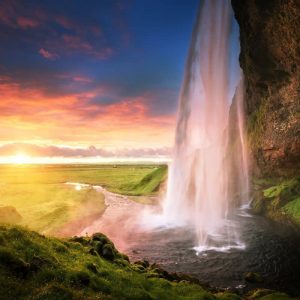全年都是冰岛旅游的最佳时间。为什么?这个问题您一定能在下面的信息中找到满意的答案。另外我们提供大量适应于各个季节的自驾行程和跟团产品供您选择。如果您有选择困难的话,或许我们可以帮到您。

冰岛每年的最佳旅游时间取决于不同的季节
夏季是冰岛旅游的最佳时间吗?
夏季是徒步爱好者的乐园。所有的冰岛高原地区都能顺利通行,您将有机会数日沉浸在高山小路中探索数不胜收的美丽风景。其中要强烈推荐冰岛最著名的Laugavegur徒步路线和Fimmvörðuháls徒步路线,这里每年都吸引着来自全球各地的游客。建议体验由专业导游带领的冰川徒步,在无数的裂缝和冰川锅穴之间行走。如果您有待瓶子,不妨装点冰岛真正的冰川水,是喝是留,您自己决定。您如果喜欢露营,那冰岛一定能满足您。冰岛户外有很多露营地,而且会有非常全面的日常设施供使用,甚至还有游泳池哟! 了解更多冰岛徒步旅行的相关信息可查询此网站。

冬季是冰岛旅游的最佳时间吗?
夏季是冰岛观鲸的最佳时机。冰岛海洋中的温柔巨兽——鲸鱼,还有可爱的冰岛国鸟——海鹦。一般很难有机会见到它们,而夏季来冰岛将有机会和这两个吉祥物碰个面。它们会在4月下旬来到冰岛,一直待到8月。因此会有很多观鲸之旅和海鹦之旅供体验,且有多个出发点可选择。我们强烈推荐在冰岛的北部体验观鲸,看到的概率会更高哟。那里有个很棒的观鲸小镇——胡萨维克(Húsavík)。夏季也是海钓的好时机,只要您喜欢,参加个海钓项目即可! 冰岛各个地方都有着不同的氛围,而如果您想要热闹,那就去首都雷克雅未克吧!冰岛人非常喜爱阳光(因为有阳光的日子太短暂啦),他们会举办很多活动和节日来创造更多的快乐! 有句话说的好,“美好总是短暂的”, 而它也适用于冰岛的夏季(美好)!所以在充满阳光的夏天是值得好好享受的(前提是不要下雨)!

冰岛的春季和秋季
“冰岛一定非常冷,到处都是冰”——这可能是很多人在来到冰岛前的想象。不过我们可以很负责的说,冰岛温度比您想象的要温和,从11月正式进入冰岛的冬季,直到来年的3月, 这段时间里,冰岛的平均温度会在0℃-10℃之间,虽然听起来很冷,但只要在室内,就是春天的感觉,毕竟冰岛有地热嘛!冬季日照时间短,北极光出现的频率非常高,炫彩斑斓的极光就像有着某种魔力召唤着仰慕者的心。入冬后的冰岛会发生有趣的变化,一些瀑布会结冰,和很多风景会被白雪覆盖了。这种景象往往有种无法言表的感觉,只有当您真正亲眼所见后能体会那种感觉。这就是冰岛的吸引力,也是它独特的魅力!

体验冰岛户外体验的最佳时间
冰岛徒步旅行
冰川是冰岛地质非常重要的组成部分,它们在冬季会有着独特的魅力,您将有机会目睹不一样的冰岛冰川。我们建议您参加由专业导游带领的冰川徒步团,登上冰川前往著名的蓝冰洞参观,由于冬季的原因,冰川会呈现更美的蓝色。您可以当场触碰冰墙的温度以及它凹凸不平的表面,这怎样的一种体验啊!到底是像玻璃,还是水晶还是黑曜石?您一定会有自己的判断。冬季里的冰川为我们打开了一个新世界的大门,这里充满着惊喜和刺激!虽然我们不知道冬天还会给我们带来什么,但我们愿意相信会是美好的!

鲸鱼与海鹦
凡是聊到冰岛就肯定会提到北极光,确实冰岛是观赏北极光的最佳地点之一。毕竟它他拥有绝佳的地理位置——靠近北极圈!从8月底至5月初这段时间都是可以北极光的,而最中间的几个月才是看北极光的最佳时间段。更多关于北极光的信息在相关攻略中详细描述,那里您会获得了解北极光的一切,同时我们还会教您如何用手机APP来捕捉极光。 冰岛冬天的北极光而增添了更多的梦幻气息,而我们会将最美的冰岛展现给您!

冰岛冰川与冰洞
冰岛的春天和冬天实际上非常短暂,让人甚至意识不到它们的存在。春季一般是4月和5月,而秋季只有9月。首先来说春季,它是冰岛进入夏季前的铺垫,摆脱冬季的黑夜后,白天时间逐渐变长,大自然中的植物们都慢慢地复苏,花草树木努力的为夏天的到来而成长着。4月最让冰岛人期待的无非是当地的节日复活节(Páskar),长假走起! 秋季(9月)到来时,能明显感觉到日照时间变短,气温也慢慢有变化,唯独不变的永远是冰岛让人捉摸不透的大风。虽然要进入冬季了,但它依然还算是夏天结束前的小尾巴,还是有机会再去做一些户外活动,比如露营(可能要比前两个月多穿点)、骑马或驾驶ATV四轮沙滩车等。如果运气好的话,9月份就能看到北极光哟。

北极光
还是那句话“冰岛全年都可以是旅游最佳时间”,没有什么不好的时间。因为在冰岛这个神奇的国度,您很有可能遇到难以置信的惊喜,以及体验各个季节打来的趣味。别再担心了,不同的季节只会让您看到不一样的冰岛。我们提供的多个匹配夏季和冬季的旅游行程中,总是会有一款适合您! 现在让我们来问您一个问题,您什么时候来冰岛找我们玩呀?

















 family
family